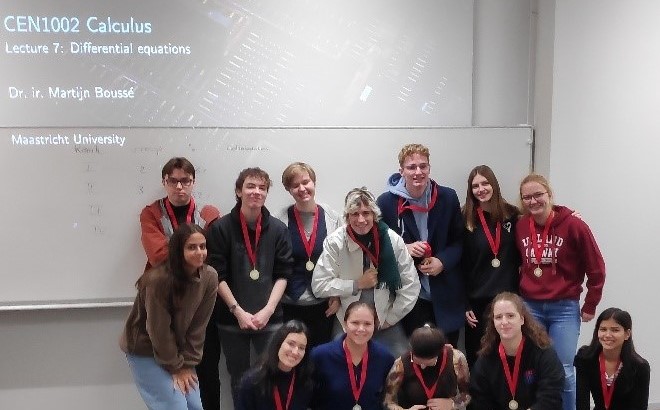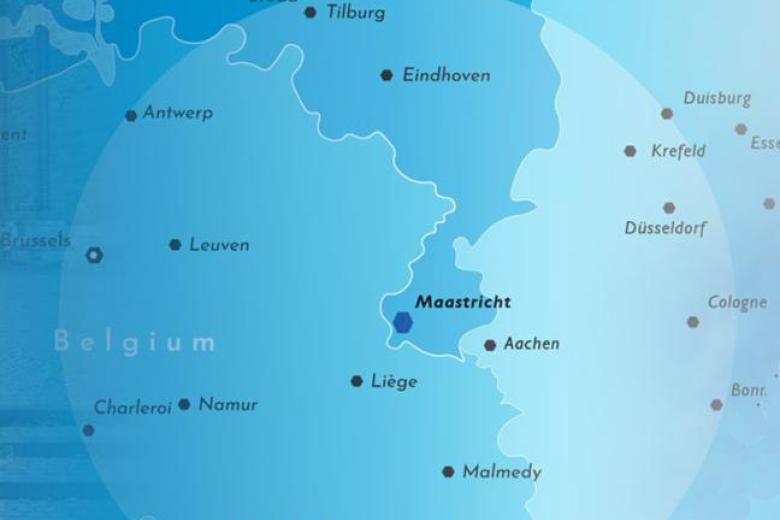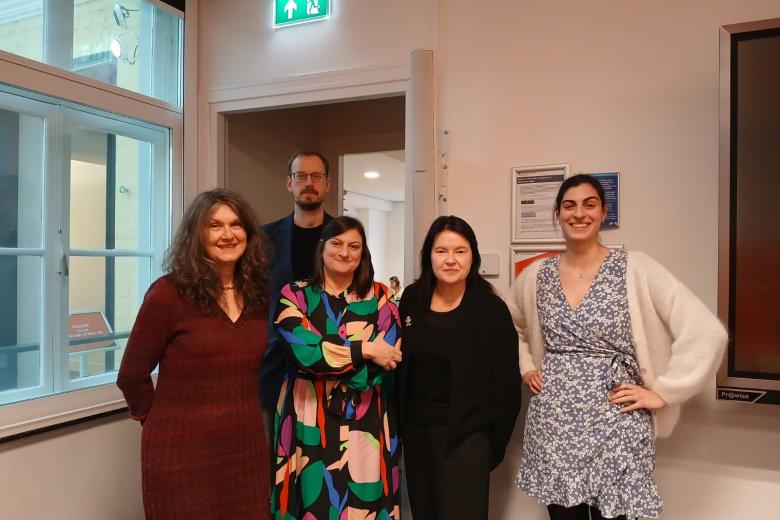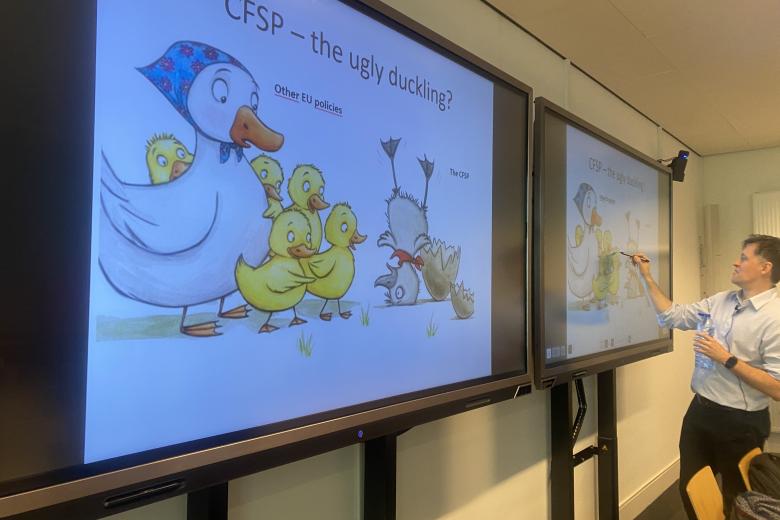Ready. Set. Integrate! Revitalising the lost art of integration in calculus through student competition
Martijn Boussé implemented an integration competition in a calculus course for engineering students. Initially, he was skeptical about the idea of introducing a competition challenge in a Problem-Based Learning setting. But the results surprised him: "If a competition can motivate students up to this point, then I feel like my job as a lecturer is done!"

Integrals
“Today, we’re going to solve integrals!” said our high school maths teacher as she bustled into the classroom with a thick stack of papers. “Well, today. And tomorrow and on Friday,” she added, handing out the papers. “Let’s be totally honest: for the coming weeks, you’re going to solve integrals in every class! You’ll be integration experts by the end of it, and that’s that.”
Although my mind might be a bit fuzzy about my teacher's specific wording and theatrics, I remember that we solved hundreds – yes, hundreds – of integrals over a span of weeks.
I was in the advanced maths class in the fifth year of high school, and our teacher made a point of drilling us hard on this particular aspect. We solved integral after integral after integral until I could solve them mentally, recognise the patterns, and ‘see’ the steps. All the basic integrals and integration techniques are so deeply ingrained into my memory that even now, I only need a few minutes to tackle complicated integrals. Drilling might be out-of-fashion in some schools, but it did work (for me), at least in this case.
A creeping feeling
After some years of practice in lecturing and (private) tutoring, I have a creeping feeling that integration has become a lost art amongst STEM-oriented students. Some high schools simply do not cover it, while some offer it as a self-study package, and COVID certainly did not help. If students are lucky, they know what an integral is and how to use substitution, but chances are that they are ill-prepared for university.
The high school graduates who end up in my Calculus course are exposed to various topics at a high pace and high stakes, next to multiple other vital activities, such as sleeping, eating, and drinking. On top of that, they face a demanding lecturer with high expectations who will not settle for less than maximal effort. Ouch.
Furthermore, they are required to take my Calculus course as one of the first mathematical courses in their programme because it lays the foundation for a range of other fundamental engineering courses, such as thermodynamics, electronics, kinematics, fluid mechanics, and statistics that follow in the programme.
Students need to learn how to use and apply the essential tools of calculus – limits, derivatives, and integrals – in order to become great problem solvers. These skills are a stepping-stone to solving real-life-like problems in other courses and, later, in a professional context, actual real-life problems for real stakeholders.
However, students have great difficulties in achieving these learning outcomes. I believe that a reason could be the (still) ubiquitous, traditional teaching and learning methods that neglect the fundamental principles of Problem-Based Learning (PBL) championed at Maastricht University. In my estimation, this deadly one-two punch of lacking prior knowledge and faltering pervasiveness of PBL in STEM sets students up for failure.
“That’s all nice, but how the hell are you going to do all that, mister lecturer?”
To combat this, I tried to set up a new assessment method focused on integration techniques in calculus. My intention was to improve student-student interaction and tickle student motivation while aligning with the UM vision on assessment, particularly the constructive, collaborative, contextual, and self-directed principles of PBL. “That’s all nice, but how the hell are you going to do all that, mister lecturer?” Well, I am glad you asked.
As part of a broader redesign of an alignment exercise for the Calculus course, I implemented an integration competition. Held during a tutorial class midway through the period, the competition counts as a team assignment for the entire tutorial group. This means that the competition pits entire tutorial groups against each other.
In this particular run of the course, there were four tutorial groups. At the start of the competition, each tutorial group received a numbered list of 200 randomly ordered indefinite integrals constructed by me.
Each tutorial group attempted to solve as many integrals as possible in 30 minutes as a team. Each integral had to be solved on a separate piece of paper that clearly mentioned the number of the integral in the list (in the top left) and the name of the student who attempted to solve the integral (in the top right).
Failure to comply with this format meant that the particular submission was discarded. Also, the entire team would be disqualified if a student wrote another student’s name on a piece of paper. However, students were still allowed to help each other orally to a limited extent. Importantly, the solutions could only be submitted during the competition, i.e., within the 30-minute window. The students were not allowed to use formula sheets, textbooks, calculators, software, laptops, phones, etc. Again, the entire team was disqualified if a student was caught cheating.
Students were allowed to discuss solutions and strategies during the competition, but obviously, the clock was ticking, so they were encouraged to discuss strategies and tactics before the competition.
What about grading?
Grading the assignment required some definitions. Each tutorial group had a target number equal to eight times the number of persons in the tutorial group, i.e., if the group consisted of 10 students, then their target number was 80. This target number defined a baseline minimum number of integrals they had to solve as a group.
For clarity, this does not mean that every student had to solve exactly eight integrals; some students could solve more than eight, and some could solve less than eight, but on average, they had to aim for eight integrals per student. The actual number of each tutorial group was equal to the number of correctly solved integrals; partial credits were not possible.
Finally, we also recorded the number of (correctly solved) integrals of the best-performing student and the least-performing student. Using these definitions, we could set up a grading scheme:
- The base grade of the group was determined by the actual and target number. If the group reached the target number, their score was equal to seven out of ten. If the group did not reach the target number, the score was weighted with a factor determined by the ratio of the actual and target number.
- A tutorial group could obtain a two-point bonus on their score if the difference between the best-performing student and the least-performing student was limited. This was set at a maximum difference of four integrals.
- The best-performing tutorial group received a one-point bonus on their score.
Based on the final grade, the best team also received an additional special prize: a gold medal with a red strap featuring an integral symbol. The competition rules and the grading scheme encouraged and rewarded team play, clever tactics, and strategy.
Collaborative, Contextual, Constructive, Self-directed
My observations before the integration competition seem to indicate that the setup allowed for increased student-to-student interaction and student motivation. Before the integration competition, students discussed various strategies, tactics, and practicalities.
Examples included a discussion on how to divide the list efficiently, how to avoid overlap, how to assign particular types of integral to specific people, how to divide themselves further into sub-teams, how to communicate with each other during the competition efficiently, how to get most bang-for-buck (depending on integral difficulty), how to double-check solutions by other team members, and many more. This only covered the part of the discussion that I supervised during the tutorials.
I was deeply impressed by the quality of the collaboration and the self-directedness of the students. The zeal and dedication that they displayed were inspiring. Additionally, the students reported that they practised over the weekend to maximise their chances. If a competition can motivate them up to this point, then I feel like my job as a lecturer is done. In the whole process, my tutor role was mainly that of a guide on the side, playing into the constructive element of the CCCS principles.

Plot twist
Coming from a very traditional teaching and learning environment, I will be honest and state that I was initially not very impressed by the PBL system and UM's vision on assessment, particularly the loosely defined CCCS principles. As a survivor of the gruelling old-school approach, as the example in the introductory paragraph highlights, I was more inclined to do it “the same way it was always done”. But, plot twist, after this experience, my cynicism is slowly transforming into fervent admiration of the CCCS principles as a guideline for designing great assessment tools.
By Martijn Boussé, lecturer Department of Advanced Computing Sciences, Faculty of Science and Engineering, Maastricht University.
This article is a publication of edUMinded, the Maastricht University online magazine on Teaching & Learning.
Interested in more Teaching & Learning stories?
Also read
-
DigiMach places Meuse-Rhine Euroregion at the heart of industrial digitalisation
DigiMach (Digital Machining) is a new cross-border project uniting Belgium, Germany, and the Netherlands around a common goal: accelerating the digitalisation of the machining industry in the Meuse-Rhine Euroregion.
-
Globalisation & Law Network seminar with Áine Ryall
On 24 November 2025, the Globalisation & Law Network, together with the Institute for Globalisation and International Regulation (IGIR) held the seminar with Professor Áine Ryall.
-
Guest Lecture: Lóránt Havas explores current challenges in the EU’s CFSP
Lóránt Havas delivered a guest lecture on the EU’s evolving CFSP, discussing key legal developments, institutional challenges, and new defence instruments.